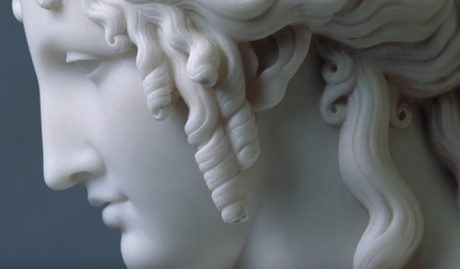12 Ideosophy

Ideosophy is like a lace scarf for the Aeonic Mother. The lace may be of diverse colors, reflecting the race-romantic mythogens of different peoples, but the color of her Aeonic substance is white.
[Antique German ceramic from Dresden.]
Theme Song: Tomorrow Belongs to Me from the Biergarten scene in Cabaret (1972)
“You still think you can control them?”
New introductory talk added May 31, 2022: The Synthesis of Learning
Among the topics and issues comprised in Humanities, some belong specifically to the genre of ideology: namely, the race-romantic ethos, racial humanism, “Gaian ethics,” contra-violence, the moral sense, the JQ, ethnogenesis, aretocracy, and historical avatars. Looking over the twelve Courses, you might well have pondered, as I have, Where does gnostic instruction on building the Sophianic mythogen fit into Nemeta? In what genre, conforming to what line of studies? Certainly, it shows up in various places but its proper locale has until now been omitted. That omission is now corrected: Constructing the mythogen is the core subject of Ideosophy. With that goal clearly determined, this Course will eventually offer some units on “ethnogenesis in the biosphere” (Lev Gumilev).
Ideosophy is the frame of ethical and ideological parameters required to establish and actualize the mythogen specific to the white races, or any race, any ethno-nationalist group, but established first for the white races to set the example and standard for others. To fulfill the race-specific mythogen is the grounding act of social responsibility, and the sole truly universal moral duty.
Put otherwise, Ideosophy is the application of moral imagination to frame and direct human existential transactions, including the moral dynamic that bonds the human creature to its source, the Supernatural, on the one hand, and the complementary dynamic that binds each human individual to a community, race, and nation, on the other. That being so, it provides an enhanced dimension of meaning to the Existentialist notion of engagement, socially framed moral commitment.
Anti-Liberalism
Its founding premises can be summarily stated by what it stands against: namely, both the idea of the free-standing individual entitled to pursue selfish goals and the counter-balancing idea of a “universal humanity” in which all members share common rights and interests. In that dynamic, the assumption of equality is basic, but it contradicts the liberal standard of freedom which allows for individuals to be different, each person defining reality on one’s own solipsistic terms. This inherent contradiction corrupts both notions, individualism and universalism. The center cannot hold in that supposed balance, thus it generates a black hole of moral instability that sucks in and annihilates all genuine and sustainable standards of morality.
By contrast, the moral outlook of Ideosophy places the individual member of society where he or she belongs, in a community identified by bloodline, birthplace, and language. No individual person stands alone and independent from its native ethnic origins. All individuals are responsible first and always to those origins. Technically, this viewpoint has been called racial realism. In Ideosophy as developed here on Nemeta, it can be rebranded as nativism, the nativist view of human values.
Framing
As will be clear so far, Ideosophy carries a rigorous critique of the social order. It asserts that “the divine experiment” has to be defined and developed by a sustained act of moral imagination. The mytheme of “the divine experiment” is meaningless, or no better than a wild fiction, without reference to the super-human and super-terrestrial agencies that established it. Thus, in Ideosophy, moral and ethical propositions come to be defined and sustained within an imaginative frame.
You find this method exemplified in the School’s unique definition of humanity as a supermundane imaginal entity manifesting in racial derivatives that are biologically real. If you cannot imagine the Anthropos genome in M42, you cannot recognize or comprehend the true nature of the biological races that derive from it. All that being so, I trust that it can now stand eminently clear that the higher education of the human races — my modification of the Romantic meme, “education of the human race,” drawn from Lessing, von Herder, and others — sets the theme for Humanities in complementation to construction of the mythogen, central to this course.
Aphoristic Style
The ongoing content of Ideosophy cannot properly be set out in exposition. It requires another style. As new content emerges, it might be presented in the aphoristic style seen in Enlightenment thinkers such as De La Rochefoucald, (1613 – 1680). Nietzsche also wrote in this style at times. Some of his works were densely argumentative, rhetorical, expressed in elaborate exposition: The Birth of Tragedy and The Geneology of Morals, for instance. There is some tough trucking even for intellectually gifted tads. On the other hand, Nietzsche also wrote in the aphoristic style, working with brief propositions (often called maxim: Hence the maxims of De La Rochefoucald. The Gay Science, Human All to Human and other polemical tracts of Nietzsche display this style. Arguably, Thus Spake Zarathustra is also composed in the aphoristic style of short, lightning-flash-like propositions. Among them is the credo of the Maine professor, adopted when I was 17, from “On Reading and Writing:”
You look up when you desire to be exalted. And I look down, because I am exalted. Who among you can at the same time laugh and be exalted?
Who climbs upon the highest mountains laughs at all tragedies, real or imaginary.
Untroubled, scornful, outrageous – that is how wisdom wants us to be: she is a woman who never loves anyone but a warrior.
The list of aphoristic writers you can examine in Wikipedia is quite extensive and includes a good number of obscure authors. I may occasionally cite these authors, some of whom are existentialists and so-called nihilists — the latter being a derogatory term applied to certain Romantics by their critics. Some but not all of the new content here will be in aphoristic form.
The Standard
Ideosophy is the product of human moral imagination as it contemplates the presence of the Aeonic Mother. This exercise of gazing toward Sophia also places the human witness in the gaze of the revered presence. There is a two-way contemplation. It is normal to picture the overseeing presence of the Aeonic Mother as a wise and benevolent maternal figure, like the Roman Minerva. The Roman name for the White Goddess was Leucothea. Minerva was the sensed projection of her mind into the mind of the human animal who reveres her.

The gaze of the Wisdom Goddess seems to solidify out of the undulant coruscations of the Organic Light. Her face may assume the look of a Greek or Roman matron. It is not strictly correct to imagine the face and figure of the Wisdom Goddess anthropomorphically, after the human form. In her state of material immanence as the living planet, it is inevitable to do so, however. In her primary state of Aeonic luminosity, not so.
The Organic Light cannot be reduced to any anthropomorphic visualization, but it has to be said that anthropomorphic and theriomorphic features play through it like massive weather fronts pulsing in the atmosphere. The Aeon projects these features into the human psyche to facilitate recognition of her presence. It can truly be said that anthropomorphic or human-resembling images of the Aeonic Mother arise as intra-psychic projections coming from Her, rather than from the human witness commonly assumed to generate those images. Once they are seen, or usually merely glimpsed, what the Mother has projected into the psyche of her pet species comes to be regarded as the product of the species. Naturally.
Thus it was that once on Infinity Ridge the Nagual saw in the sky the image of the Aeon Sophia resembling the face of a Roman matron recalling Minerva (Greek Athena). And the thought came instantly, “Yes, she has often been pictured like that” (above). As soft molten marble, curling locks and all. This image of a human face in classical style of white Aryan nobility might be the appropriate visualization to hold in mind whenever delving into the material of Course 12. Picture the Mother beholding you in this way, if you like. It cannot be harmful or misleading. And contemplate that face beholding you as you recall the standard of this work:
To describe and demonstrate the operations of human imagination coupled with divine imagination
The Course in Ideosophy is your commitment to uphold that standard and bring it to life.
jll – September 2019 Galicia – July 2022 Galicia
12 Ideosophy: Course Curriculum
- 12 HIGHLIGHTS/PREVIEWS
- 12 The Ideological Power of Music
- 12 An Epiphany of Lady Sophia
- 12 The Infliction of Suffering
- 12.101 CRITERIA FOR A-11
- 12.101 Elan Vital: The Mysterious Propulsion of Previance
- 12.101 DHL and the Religion of Blood
- 12.102 THE HUMANITIES
- 12.102 Humanities (Previous Vocation Landing Page)
- The Synthesis of Learning
- 12.103 BACKGROUND STUDIES
- 12.103 On Existentialism
- 12.103 Background to Metahistory
- Private: 12.103 Essential Reading
- Private: 12.103 Four Concerns
- 12.103 Stalking the Meta-Narrative
- 12.104 THE RAGLAN FILES
- 12.104 One: The Raglan Motifs
- 12.104 Two: Scripting Formulas in Myth and History
- 12.104 Three: Hot Takes from Raglan
- 12.105 THE SEEKER'S LIBRARY
- 12.105 Introduction ESL 1991
- 12.105 ESL 1 : Eastern Classics
- 12.105 ESL 2 : Western Classics
- 12.105 ESL 3 : Background
- 12.105 ESL 4 : Breakthrough
- 12.106 SOCRATES AND STOICS
- 12.106 Socrates in the Last Days
- 12.106 A Socratic Wrangle
- 12.106 An Essay on Stoicism
- 12.107 ADVERSARIAL ETHICS
- GAIAN ETHICS AND NATURAL LAW
- Private: 12 Previous Contra-Violence Landing Page
- Private: 12 Previous Landing Page of Contra-Violence Reconsidered, CAVEAT
- 12 The Riddle of Violence I
- 12 The Riddle of Violence II
- 12 The Riddle of Violence III
- 12 Karma and Accountability
- Private: 12.107 Open Season on Predators I
- Private: 12 Open Season Part II
- 12.100 Social Evil and the Master Scam
- 12 Themocracy: Outline of a Consential Code
- HUMANITIES
- 12.102 Humanities (Previous Vocation Landing Page)
- The Synthesis of Learning
- 13 Audio – My Vision for Recovering The Humanities
- 12 IN DEVELOPMENT
- Private: 12.1 Moral Imagination
- Private: 12 The Gnostic Adversary
- Private: 12 Why the JP?
- Private: 12 SET I The Divine Experiment
- Private: 12 SET II The Non Plus Ultra